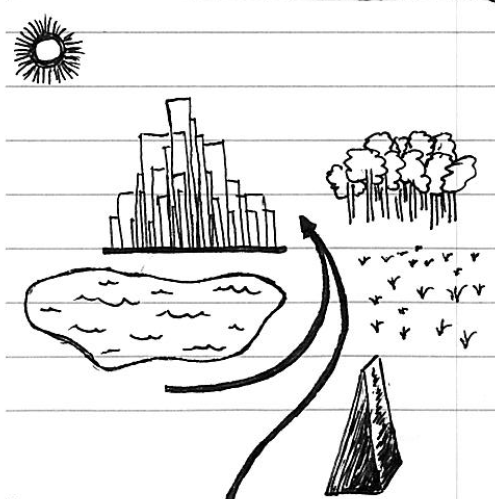While my 16-year-old sister was at the beach last month, she stopped by the local bookstore and bought me a copy of The Image of the City by Kevin Lynch. Amazing. A lot has changed since it was published in 1960, but the main idea is just as important today: we should work to enhance the quality of the experience of each city. Is the city easy to navigate? Is it memorable? Is it hospitable?
Throughout the book, Lynch uses small drawings to explain his theories. Now, instead of practice my signature when I’m bored, I’ve been doodling:

This is my idea of the best highway experience. The road travels toward the city, embraces the full broadside view of its beauty, then bends around. In Richmond, there is a reoccurring conversation about the view of Richmond from the highway (especially traveling south on I-95). Lynch’s research gives good context to this and similar, ongoing conversations.
To explain his desire to improve cities, Lynch uses the terms legible and imageable. Basically, does it make sense and is it memorable? If it doesn’t make sense to the viewer then it won’t be memorable. I have to add, you want your city to memorable for the right reasons: beautiful, consistent, dramatic, historic, dynamic, creative, vibrant, efficient.
To describe the “imageable city,” Lynch chooses five elements that he believes make up the urban experience. Each of these can either be completely forgettable or incredibly memorable. Here are some examples from Richmond:
- Paths (Monument Ave., Grace St., the Boulevard)
- Edges (the James River)
- Districts (The Fan, Church Hill, and many others)
- Nodes (downtown, Carytown, MacArthur Ave.)
- Landmarks (The Sailors and Soldiers Monument, The Carillon)
Fortunately, Richmond has been blessed with examples that show off the potential beauty of each element. At the same time, there are many issues with the “Richmond image.” To many, it’s a confusing and disconnected city.
To move forward, we need to find simple ways to turn everyday elements into memorable, quality experiences. For decades, economic development in Richmond equated to wedging large-scale projects in or near the central business district. These projects aren’t going to improve the overall experience of the city. In contrast, improving the most basic elements—paths, edges, districts, nodes, and landmarks—will gradually create what Christopher Silver refers to as the “Good City.”
The real lesson of the book is that urban form is important from border to border. It’s a lesson for us as we work to create the best possible Richmond: a city that is coherent, beautiful, and vital.
